My reader will perhaps be rather puzzled as to why my first picture in a North Korean money review is of a 100 Chinese Yuan bill after which I feature some Euros and an American note while the local currency of North Korea, the Won, is relegated to fourth place.
The answer to this conundrum is very simple. With one exemption, which I will come to later, it is forbidden for tourists to possess or use Wons in North Korea and with no exceptions it is illegal to take it out of the country.
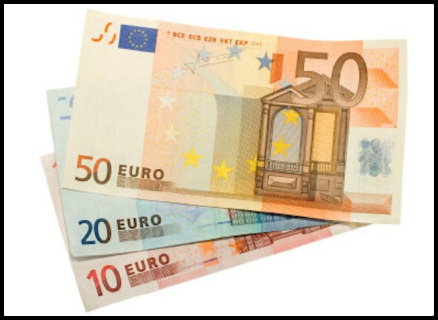
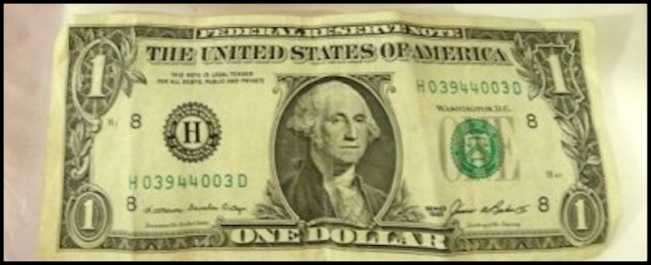
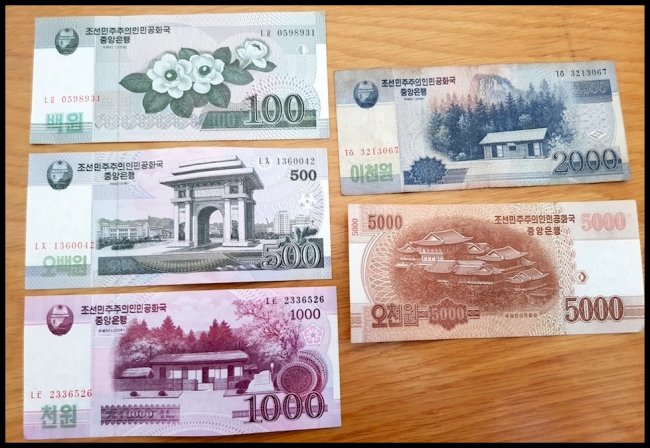
The preferred currency in North Korea is the Chinese Yuan followed by the Euro and then the US Dollar. Yes, the North Korean dislike of the US (see my separate entry – “Americans in North Korea” ) does not extend to the US dollar!
The preference for the Yuan (businesses in the north-east which borders with China refused to accept anything else) represents a major change from when I last visited the country in 2014 when there was a very clear preference for the Euro – followed by the US$ and then the Yuan.
Certainly from my perspective this shift can be accounted for by one thing only and that is sanctions. In the past couple of years crippling sanctions imposed on North Korea by the outside world has made it very difficult for the country to import goods and services. The cruelty and coldheartedness with which individual countries – in particular those less subject to the influence of the US – implement the sanctions varies. While trade with China has declined significantly since 2016 (see below) it still exists hence a shift of preference to the Yuan.
As a side note, even with sanctions, based on my very limited examination of goods available in shops, I am of the view that the level of foreign consumer goods on sale, certainly in Pyongyang, has actually risen since 2014. The only notable decline was in produce from Singapore. Goods from that country, mainly food and beverages, proliferated in 2014.
Rather ironically, given the US’s current position on trade with North Korea, there has been a massive growth in the availability of Coca Cola products throughout the country since 2014 when finding a Coke was more akin to finding a needle in a haystack. My reader may be aware that Coca Cola, that inescapable symbol of the global appeal of American-style consumer culture, does not formally operate in only two countries in the world those being North Korea and Cuba. The coke on the shelves in North Korea comes from China.
I fear I have wandered of track, again!
Back to money …….
There are a few matters related to money that you need to be aware of before going to North Korea:-
- There are no ATM machines (cash dispensing machines) in North Korea;
- You cannot have money transferred into North Korea;
- You cannot change travellers cheques or any other form of normally negotiable instruments in North Korea; and
- Foreign credit cards cannot be used anywhere in North Korea.
The above means that you must bring in cash (in one or more of the currencies mentioned) in sufficient quantity for the duration of your trip. Do bring clean and unwrinkled notes of as small a denomination as you can find (Euro coins can be used) as change is sometimes hard to come by. In terms of change and transacting in foreign currency more generally what I found amazing is how shop assistants, bar staff, etc can operate in/ take multiple currencies for one transaction and give you change in multiple currencies – with the odd stick of chewing gum or other sweet thrown in if enough change is not available. One of our group was even given a few Won by way of small change – though a very minor amount, a faux pas on the seller’s account.
As you will be on an all expenses pre-paid trip the amount of money you need is limited to what you want to spend on additional drinks, extras such as pizza, fun park rides, dog meat, souvenirs, special event entrance fees e.g. mass games and tips for your guides. Outside, special event fees, tips and souvenirs and allowing for a couple of beers a day you can easily get by on around 10-20 Euros per day. Your tour company will advise you on recommended tips and special event entry fees in advance of your travel.
Back in 2014 (during my last visit to the DPRK) the holding, using or taking out of North Korea of any Won was illegal.
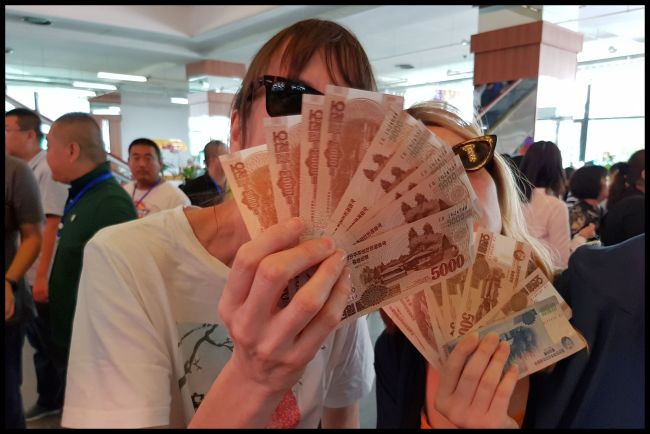
In 2018 we were permitted to change money at the Kwangbok Department Store (there are a number of stores were money can be similarly changed) to the extent that we wished to buy things in that store. Any unused Won was to be reconverted to foreign currency prior to leaving the store. Suffice it to say that there were no controls in place to ensure money was changed back. Though it could not be used elsewhere within North Korea many availed of the opportunity to ‘souvenir’ small amounts. While these ‘souvenirs’ could have been confiscated on exiting the country I have heard no reports that any were.
Of some relevance is the fact that there are two exchange rates in existence. The first is referred to as the ‘official’ rate (around 100 North Korean Won to the US$) with the second being the ‘real’ exchange rate (around 8000 Won to the US$). Outside the stores referred to above the tourist transacts (albeit behind the scenes – as the seller converts their won prices to US$, etc) at the official rate. Given that hard currency shops display a significantly lower won cost for items the savings from shopping in ‘Won’ shops is not as high as the difference between the raw exchange rates would indicate though it is still significant – i.e. Won stores are multiple times cheaper for similar items.
A recent reader of my 2014 review on taxis (now somewhat out of date more generally) alerted me to the existence of an exchange rate of 900 Won to the US$. I have located this rate quoted on various exchange sites such as XE.com and can only guess that it relates to official international transactions with the country (few though they would be at present). This rate is certainly not used within the country – or maybe better to say that I did not come across it while there in 2014 or 2018.
The enforcement of rules around spending hard currency outside the hotels, shops and restaurants you will be brought appears a little unclear. Officially you are not permitted to do so. In 2014 one of our group tried to procure an ice cream from a stall outside a flower-show we attended. While the vendor seemed interested in transacting business our guides brought the transaction to an abrupt end by indicating that it would be easier to buy an ice cream at our next stop – North Korea’s only public ten pin bowling alley, as it was. The vendor immediately lost interest in the sale when the guides intervened and the tourist was guided away to their bus. I didn’t notice any of our group put this rule to the test in 2018. I stand to be updated on this matter.
The North Korean Economy
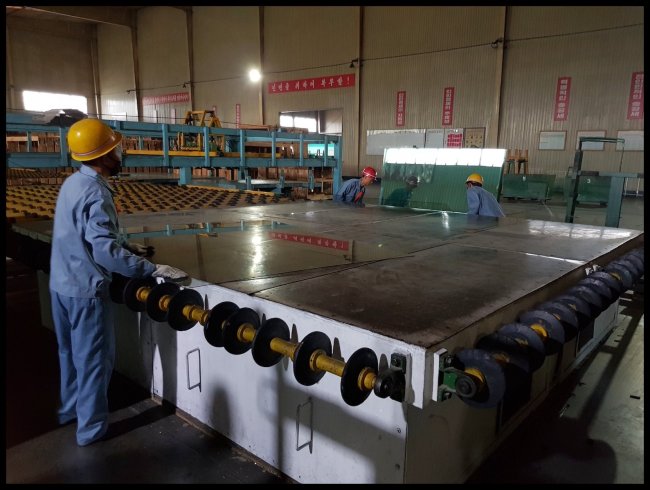
Given the paucity of verifiable/reliable information on the economy I am going to limit my comments to a few dot points:-
-
-
- The North Korean economy is a centrally planned command economy with a next to zero (though emerging under Kim Jong-un’s limited market liberalisation) private sector;
-
- The collapse of the Soviet Union (North Korea’s then principal source of support) and other Eastern Bloc countries between 1989 to 1991 forced a shift in economic (and indeed political) allegiances and China is now the country’s largest trading partner by far. Over 80% of North Korean exports went to China in 2016 and 2017. It should be noted that trade, in dollar terms, with China has declined significantly over the last couple of years due to UN based sanctions;
- As depicted on the chart below, up until about 1970 the North and South Korean economies ran pretty much in parallel, in terms of GDP. At that point the South’s economy took off and now the divergence between the two (for those seeking to draw parallels) is vastly different – larger – than between those of West and East Germany when they merged into a unified Germany (Data: Maddison Project, Bank of South Korea)
-
-
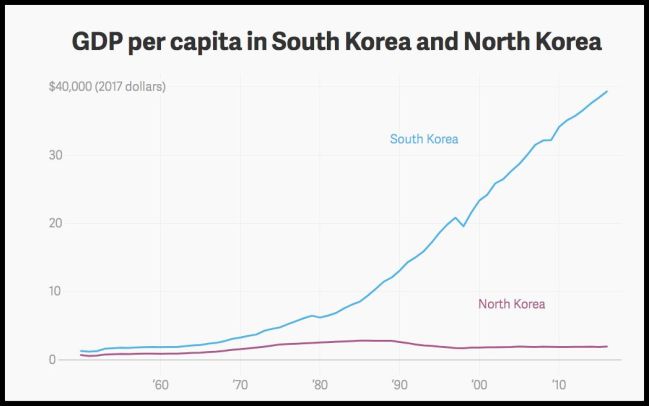
- North Korea’s gross domestic product in 2016 was around $2,000 per capita making it one of the lowest in the world. I hasten to add this figure does not in any way equate to an average wage within the country. Data on this is difficult to ascertain though through comments made by and discussions with guides I ascertained that wages in hand are minuscule. We were advised that wages were hardly relevant as everything needed was provided to the people by the state, for free or for next to nothing. Accordingly wages were a little cream on the top which provided for a small amount of discretionary spend. My personal observation suggested that some had more cream than others and, leaving aside the top end of town, between 2014 and 2018 I noticed a significant burgeoning in what might be referred to as a middle class;
- The primary components of the country’s GDP, in 2014 (est.) were mining and industry 34.4%, services 31.3%, agriculture and fisheries 21.8%, construction 8.2% and utilities 4.3%. These figures belie my feeling that subsistence farming employs the majority of North Koreans; and
- In 2016 the economy grew at a very respectable 3.9%, by far its best rate in over a decade. I suspect a construction boom in Pyongyang accounted for a significant proportion of this growth. While later figures are not available growth has certainly slowed with the strengthening of sanctions and other embargoes in 2017-2018 though it is still thought to be positive. What has declined rapidly over recent years has been global exports – as depicted below (Data: Maddison Project, Bank of South Korea). Eighty percent of the country’s exports are to China.
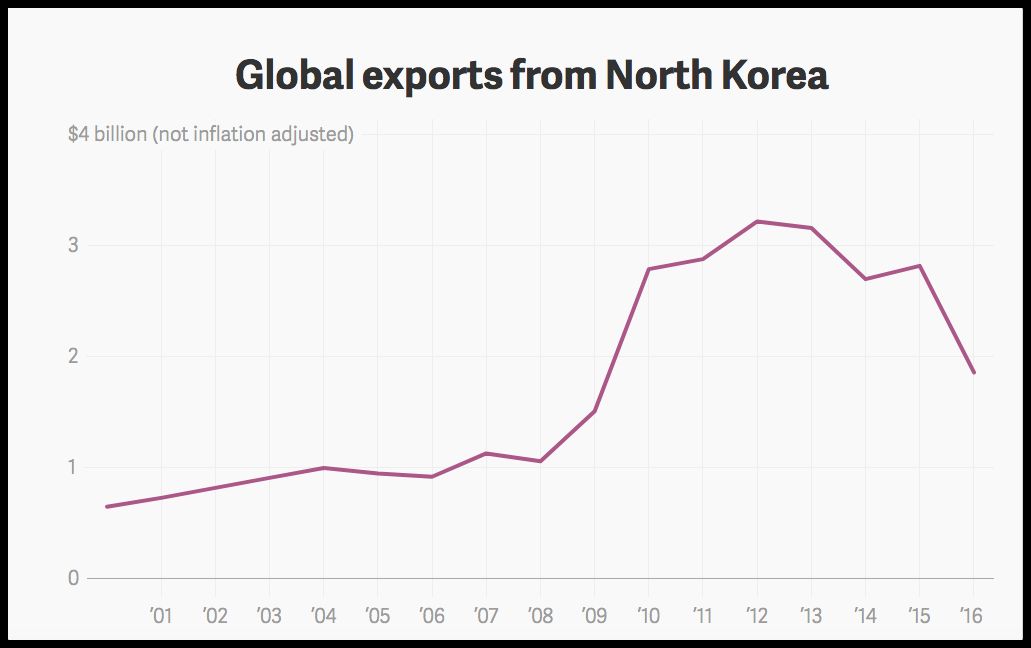
Whether or not many conventional economic indicators are a good way to look at the state of the North Korean economy is debatable. What is clear nonetheless is that North Korea is a very poor country and its citizenry does it hard.
My next North Korea 2018 – General Review – HERE
Return to the beginning of my North Korea 2018 – General Review –HERE


I have found your articles on the DPRK really insightful. I took Chinese yuan and euro with me. I used euro for larger transactions such as the ticket for the Arirang Mass Games (€100) and Chinese Yuan (CNY) for the smaller purchases such as bottles of water. I was actually surprised to see euro coins in circulation too! At the stamp museum I received €1 and €2 coins in change.
When I visited the Kwangbok Department Store, I changed €10 for ₩10,000. I had around ₩800 left – I intended on “forgetting” I had it and leaving it in the back pocket of some shorts and packing it deep in my suitcase for my trip home. However, I was able to spend ₩500 at another location. On the way to the DMZ we stopped at a roadside rest stop. I noticed some locals selling apples which looked pretty good. I asked my guide and he took the note from me and handed it to the vendor who promptly peeled the apples and handed them to me.
I found the guides quite relaxed and have been wondering if they were becoming less overzealous. What do you think?
LikeLiked by 1 person
Thank you for reading various of my NK reviews. I am glad you found them insightful and now I look forward to reading about your own impressions and how they compare with mine. Outside one guide (in the North East) I too found the guides relaxed and lovely people. The guy in the north east was overzealous without doubt but the others, not at all.
LikeLiked by 1 person
Did you notice any differences in attitude between your visits. On my trip another Australian mentioned to me that he felt the country had changed since his first visit in 2016. There was more neon signage, more smart phones being used and the guides were much more relaxed in terms of allowing photography and videos. Was that your experience?
LikeLike
Fascinating as always.
LikeLiked by 1 person
Did you spend much money on dog meat Albert?
LikeLike
Haha – Well spotted … Nil on both visits and I advise against eating it. It generally comes, within a soup, at a cost of 5 Euro as I recall, and while many get it only a small number consume it. To my discredit I tasted it many years ago now in Vietnam – not recommended.
LikeLiked by 1 person
Both fascinating and informative 🙂 Your currency advice is especially welcome
LikeLiked by 1 person
Thank you Sarah – I didn’t add it (at it will vary from place to place) but I suspect you’re best deal on getting Yuan will be to get it in Beijing .. readily available from ATM’s. I imagine it would be expensive to buy (hard to get) in UK – it certainly is in Australia. I suggest you take Euro’s too. Forget about US$ and GBP not accepted.
LikeLike
That’s helpful, thanks. At the moment the advice from our tour company is to take a mix of Euros and US$, they haven’t mentioned Yuan, so I will query that with them
LikeLike